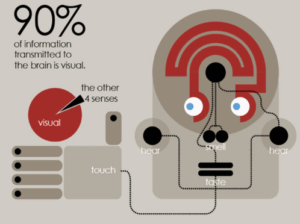Everyone loves a good story. Whether around the office water cooler or in your news feed, if a story makes you laugh or cry, it got your attention and spoke to you. Our brains are far more engaged by storytelling than a list of facts: it’s easier for us to remember stories (Gillett, 2014). On social media, with face-to-face communication not an option, storytelling is one of the only ways to reach your audience.
Social media has evolved significantly over the years. Now, because of society’s ever-decreasing attention span, channels have had to “speed up” the internet and make it more interesting and engaging. And one of the easiest ways to do that is to add images, both moving and still.
Photos and Images
Visual elements immediately draw more notice to a post. Eye-tracking studies show that internet readers pay close attention to information-carrying images. When images are relevant and visually pleasing, readers will spend more time on the page or post (Mawhinney, 2017). And since social media is (more often than not) used to increase and encourage engagement with a brand, visual elements can be a valuable way to help achieve that goal. Studies have shown that people remember only about 10 percent of the information they hear three days after they hear it—but when a relevant image is paired with that same information, people retained fully 65 percent of the information three days later (Mawhinney, 2017). The platform utilized is a key factor in what type of element to use. For instance, Instagram performs well using photos, because that’s what the platform was designed for.
Video
If a picture is worth a thousand words, how many is a video worth? Well, one minute is about 1.8 million words, so “a lot” (N.A., 2016). YouTube is the second most popular social network as of late 2016, and video-heavy Snapchat, Periscope, and Vine are at the top as well. Almost every major social network — including Facebook, Twitter, Google+, Instagram, LinkedIn, and more — has made it easier to upload, view, and share videos (Clarine, 2016). In the world of social, to get engagement you need to stop viewers from scrolling and one of the best ways to do that is to create movement within the feed. At UMSocial, on platforms such as Facebook, videos perform far better than photos and significantly better than text-based posts.
Facebook Founder Mark Zuckerberg said, “As our internet and networks are getting better, we can start to support more video — we can upload videos, we can do this live like we’re doing here, and that is making this experience richer and richer and you’re getting a better sense of what people are experiencing and feeling, which is really powerful” (Hutchinson, 2016). Utilizing the power of video in content can help motivate audiences to engage more. A video can increase content conversation by 86 percent (Joyce, 2016).
There’s room for both still and moving images in your social media content palette. Each does different things well. But if video has the ability to offer both sight and sound, reaching two of the senses, doesn’t that make it more powerfully appealing than a photograph?
As Always,
Be social. Stay social. #UMSocial
Post written by McKenna Whipple, Social Media Content Strategist at The University of Michigan.
Boland, Gabriele. (2017). Instagram video vs. photo: 7 surprising statistics on strategy. NewsWhip.
Clarine, Brenna. (2016). 11 Reasons Why Video is Better Than Any Other Medium. Advanced Web Ranking.
Gillett, Rachel. (2014). Why We’re More Likely To Remember Content With Images And Video. Fast Company.
Hutchinson, Andrew. (2016). New Research Shows Video Content Outperforming All Other Types on Facebook. Social Media Today.
Joyce, Lucien. (2016). 6 Types of Visual Content You Need to Use in Your Marketing Campaigns. Kissmetrics.
Joyce, Lucien. (N.D.). Why Infographics? Mammoth Infographics.
Mawhinney, Jesse. (2017). 42 Visual Content Marketing Statistics You Should Know in 2017. Hubspot.
N.A. (2016). WHY VIDEOS ARE MORE EFFECTIVE THAN STATIC ADVERTISING. Visual Narrative.






